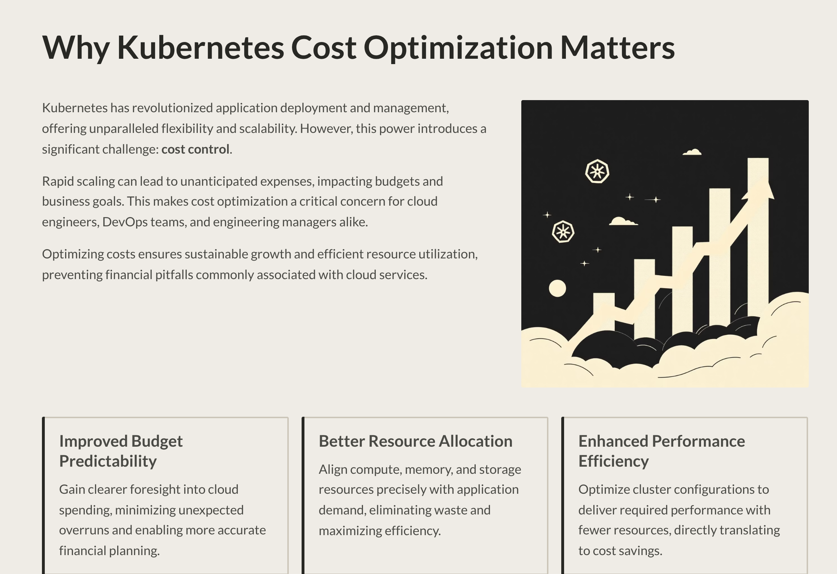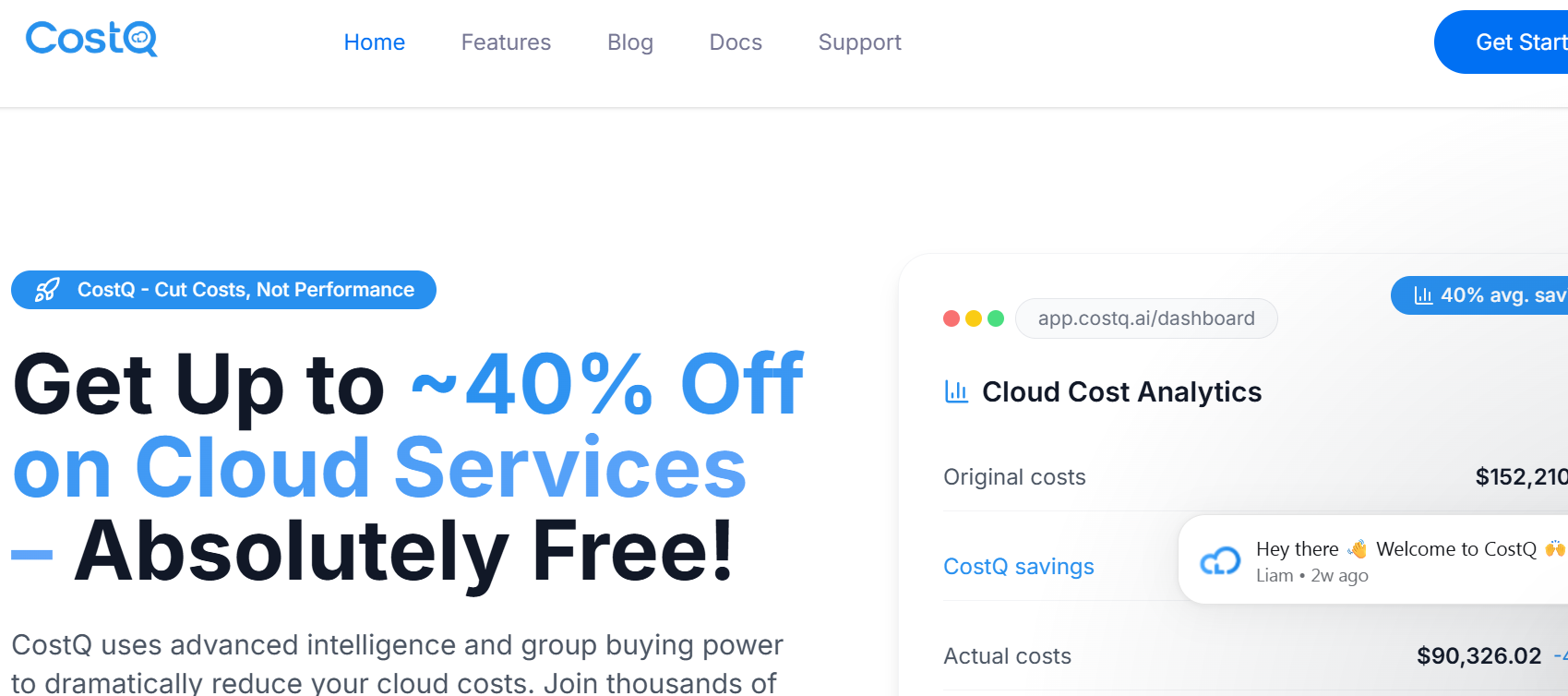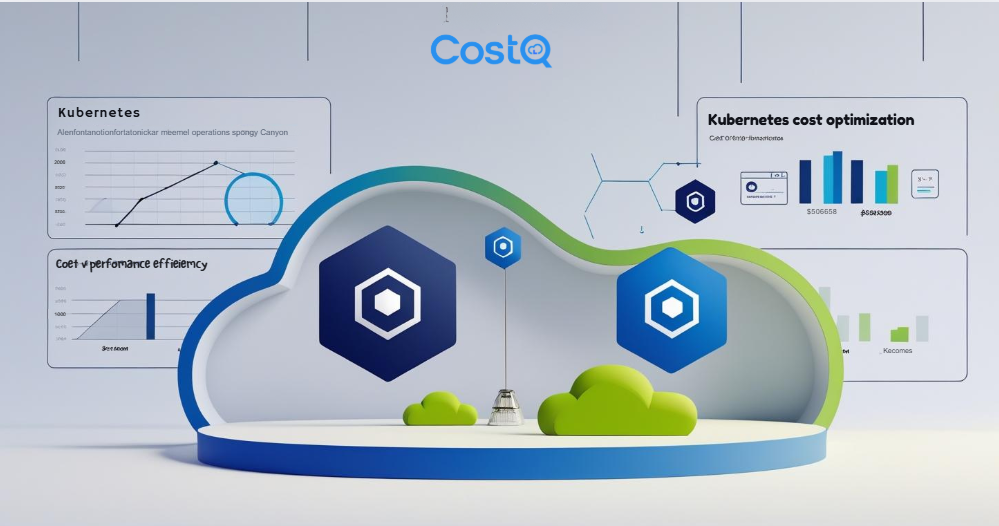Kubernetes is a powerful tool for managing containerized applications. However, without proper oversight, it can lead to high costs.
Cost optimization in Kubernetes is crucial for maintaining budget efficiency. It involves monitoring, analyzing, and reducing unnecessary expenses.
Automated solutions, like pod rightsizing, can significantly improve ROI. They ensure resources are used efficiently and effectively.
AWS cost optimization strategies can also be applied to Kubernetes. This helps in reducing cloud expenses and enhancing resource utilization.
In this guide, we explore best practices for Kubernetes cost optimization. We also highlight top solutions for managing costs effectively.
Why Kubernetes Cost Optimization Matters
Kubernetes has revolutionized how businesses deploy and manage applications. However, with this flexibility comes the challenge of controlling costs.
Rapid scaling can lead to unanticipated expenses, impacting budgets and business goals. This makes cost optimization a critical concern.
Optimizing costs ensures sustainable growth and efficient resource use. It helps businesses avoid financial pitfalls associated with cloud services.
Key benefits of Kubernetes cost optimization include:
- Improved budget predictability
- Better resource allocation
- Enhanced performance efficiency

Without a strategic approach to cost management, organizations risk overspending. Effective optimization leads to more predictable cloud spending and better resource use.
Key Principles of Kubernetes Cost Optimization
Effective cost management in Kubernetes hinges on a few guiding principles. Understanding these can lead to significant savings and better financial health for an organization.
Firstly, visibility into resource usage is paramount. Accurate tracking is essential to identify cost inefficiencies.
Next, embrace automation. Tools that automate processes can reduce manual intervention and errors.
Crucial principles include:
- Monitoring and analysis
- Automation and rightsizing
- Aligning costs with business objectives
Developing a culture of awareness about costs ensures teams make informed decisions. Such practices ensure cost efficiency aligns seamlessly with operational goals.
[ You May Like This :Low Cost Cloud Management ]
Common Cost Drivers in Kubernetes Environments
Understanding cost drivers in Kubernetes can reveal why expenses rise unexpectedly. Containers promise agility, but hidden costs lurk when usage isn’t optimized.
Several factors can lead to increased expenditure. Resource over-provisioning is a frequent culprit. Allocating more CPU or memory than necessary results in waste.
Another factor is idle resources. Unused or orphaned resources continue accruing costs.
Typical cost drivers include:
- Resource over-provisioning
- Idle and orphaned resources
- Inefficient scaling policies
Addressing these issues requires ongoing vigilance and adjustment. Optimizing each driver effectively keeps expenses in check.

Best Practices for Kubernetes Cost Optimization
Optimizing Kubernetes costs requires strategic practices. Several tactics can curb unnecessary spending while enhancing performance. Embracing best practices can pave the way for significant savings.
Key practices include:
- Rightsizing resources and preventing over-allocation.
- Implementing autoscaling to match demand with supply.
Additionally, leveraging alternative instance types reduces costs further:
- Spot and reserved instances offer discounted pricing.
- Setting resource quotas ensures efficient usage.
Monitoring resource consumption is vital for cost control. Regular audits and analysis reveal saving opportunities. Cleaning unnecessary resources can swiftly trim expenses. Optimizing storage and network usage is crucial too.
Overall, these best practices establish a robust framework for managing Kubernetes costs effectively.
1. Rightsize Your Resources
Rightsizing ensures optimal use of allocated resources. It prevents waste by adjusting CPU and memory.
Steps to rightsize include:
- Analyzing application needs for accurate provisioning.
- Regularly reviewing usage patterns to avoid over-provisioning.
Rightsizing aligns resource allocation with actual needs. This balance leads to significant cost reductions. Implementing automated tools makes this process seamless.
2. Implement Autoscaling
Autoscaling aligns resources with demand fluctuations. It automatically scales applications up or down.
Benefits of autoscaling:
- Efficiently using resources based on real-time requirements.
- Avoiding manual intervention which might lead to errors.
Deploy autoscalers across various workloads. This ensures only necessary resources are utilized. Control costs better by aligning supply with demand.
3. Use Spot and Reserved Instances
Spot and reserved instances offer savings on cloud expenditures. These cost-effective choices optimize resource allocation.
Benefits include:
- Lower cost alternatives to on-demand instances.
- Flexibility in use, maintaining performance levels.
Spot instances suit non-time-sensitive tasks. Reserved instances are ideal for long-term projects. Both options provide impactful cost reductions.
4. Set Resource Quotas and Limits
Enforcing quotas avoids overuse by capping resources. Set precise limits aligned with project requirements.
Advantages involve:
- Preventing resource abuse by defining clear boundaries.
- Encouraging mindful resource allocation by teams.
Quotas and limits ensure better control over usage. This keeps Kubernetes environments efficient. Implementing them curtails unnecessary expenses.
5. Monitor and Analyze Resource Usage
Consistent monitoring highlights inefficiencies. Analytical tools uncover patterns and areas for savings.
Key monitoring actions are:
- Deploying tools like Prometheus for continuous tracking.
- Regular data analysis to identify underutilization.
Monitoring ensures resources match needs and performance goals. Proactive analysis enables strategic cost management.
6. Clean Up Idle and Orphaned Resources
Maintaining unused resources leads to higher costs. Clearing these immediately impacts expenditure.
Steps for cleanup:
- Conduct routine audits to identify idle resources.
- Remove orphaned containers that drain finances.
Frequent audits expose wasteful components. Swift action liberates resources, conserving budget.
7. Optimize Storage and Network Costs
Storage and network expenses require strategic optimization. Addressing these lowers overall Kubernetes costs.
Strategies include:
- Utilizing efficient storage solutions tailored to workloads.
- Optimizing network configurations to reduce data transfer costs.
Assessing current usage patterns identifies savings areas. Effective optimization aligns storage with application needs. Networks benefit from careful planning and resource allocation.
Top Kubernetes Cost Optimization Solutions
Finding effective tools is crucial for managing Kubernetes costs. Several solutions offer diverse features tailored to unique needs. They integrate well into existing systems, providing seamless cost management.
Key aspects for choosing these tools include:
- Ease of integration with Kubernetes environments.
- Comprehensive analytics to guide decision-making.
- Scalability to grow with business demands.
Investing in the right tool can yield significant savings. The benefits include improved resource utilization and transparency in spending. Let’s explore some standout solutions.
Kubecost
Kubecost provides in-depth insights into Kubernetes spending. It offers detailed cost allocation and usage data.
Key features include:
- Real-time monitoring for proactive management.
- Cost allocation per namespace, team, or application.
Kubecost ensures decisions are informed by precise data. This clarity enhances both planning and execution.
CostQ
CostQ focuses on automation for cost efficiency. It optimizes Kubernetes clusters by managing resources dynamically.
Notable features involve:
- Automated cost-saving recommendations based on real-time analysis.
- Cluster management that automatically adjusts to usage patterns.
These features help in maintaining optimal performance levels. CostQ ensures sustainable cost management.

Spot by NetApp
Spot by NetApp specializes in leveraging spot instances. It dynamically optimizes the cost of running applications.
Its benefits include:
- Automated instance management to reduce manual oversight.
- Cost savings without compromising performance or reliability.
This tool ensures that applications run seamlessly, even on budget-friendly instances.
Densify
Densify enhances Kubernetes performance through predictive analytics. It provides precise recommendations for resource adjustments.
Features to note:
- AI-driven predictions for accurate resource planning.
- Continuous optimization to align with changing requirements.
Densify optimizes resource use and minimizes waste. This leads to better financial planning.
OpenCost
OpenCost is an open-source solution for cost visibility. It offers transparency in resource spending within Kubernetes.
Highlights include:
- Open-source framework for adaptability and customization.
- Detailed cost metrics for Kubernetes workloads.
Using OpenCost fosters understanding and control over financial aspects. It empowers users with actionable insights.
CloudZero
CloudZero emphasizes cloud cost intelligence. It aligns spending with business metrics and goals.
Important features are:
- Business-metric alignment for cost efficiency.
- Advanced analytics providing clarity on spend impact.
CloudZero enables strategic decision-making in a cost-effective manner.
Integrating AWS Cost Optimization with Kubernetes
Integrating AWS cost strategies with Kubernetes enhances cost control. This merger maximizes cloud efficiency. AWS offers flexible pricing models fitting diverse Kubernetes needs.
Key strategies include:
- Utilizing AWS Reserved Instances for long-term workloads.
- Leveraging Spot Instances to lower costs.
- Applying AWS Savings Plans for consistent savings.
These strategies promote financial predictability within Kubernetes environments.
Automated Pod Rightsizing Solutions with High ROI
Automated pod rightsizing solutions ensure Kubernetes resources align with actual demand. This approach boosts efficiency significantly. It helps reduce unnecessary resource usage, thus lowering costs.
Key benefits of automated rightsizing include:
- Enhanced resource allocation based on real-time usage.
- Reduced operational costs through efficient scaling.
- Improved return on investment (ROI) by optimizing resource utilization.
Leveraging these solutions can lead to substantial savings and better performance.
Building a Cost-Conscious DevOps Culture
Fostering a cost-aware DevOps culture involves educating teams about financial impacts. It encourages smarter resource use.
To build this culture, consider:
- Regular training sessions on cost management tools.
- Incorporate cost discussions in regular team meetings.
- Recognize and reward cost-saving initiatives.
Implementing these practices promotes efficiency and reduces unnecessary expenses.
FAQ’s Related to Kubernetes Cost Optimization
❓ How can I reduce the cost of Kubernetes?
You can reduce Kubernetes costs by rightsizing workloads, enabling autoscaling, using Spot or Reserved Instances, and cleaning up idle resources. Monitoring tools like Kubecost, Prometheus, and OpenCost provide real-time visibility to identify cost-saving opportunities.
❓ How does Adidas cut Kubernetes costs by 50%?
Adidas achieved a 50% reduction in Kubernetes costs by implementing automated rightsizing, cluster autoscaling, and advanced monitoring tools. They also leveraged Spot Instances for non-critical workloads. This case study highlights the importance of automation and cost visibility.
❓ What is cost optimization in AKS?
Cost optimization in Azure Kubernetes Service (AKS) means applying strategies like rightsizing node pools, using Azure Reserved VM Instances, leveraging Spot VMs, and monitoring cluster usage. Microsoft provides built-in tools, such as Azure Advisor and Cost Management, to optimize AKS expenses.
❓ How much does IT cost to run Kubernetes?
The cost of running Kubernetes depends on cloud provider (AWS, GCP, Azure), workload size, and resource usage. On average, businesses spend thousands per month on clusters. Costs include compute, storage, networking, and management overhead. Effective Kubernetes cost optimizations can cut these expenses significantly.
Conclusion: Making Kubernetes Cost Optimization an Ongoing Practice
Kubernetes cost optimization should never be a one-time effort. Continuous monitoring and adjustments are crucial to ensure lasting efficiency.
Adopting a dynamic approach can maximize resource utility and align costs with business needs. This proactive strategy will foster sustainable financial health and operational excellence over time.
These Blogs May Be Helpful for You
AWS Fargate: The Complete Guide to Serverless Container Computing in 2025
The Complete Guide to Creating Amazon S3 Buckets : From Beginner to Pro
EC2 Savings plan analysis: Spot vs. On-Demand vs. Savings Plans at Scale
AWS EC2 Instance Types Explained
